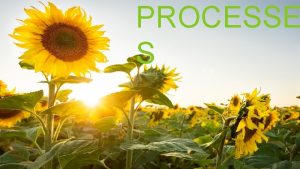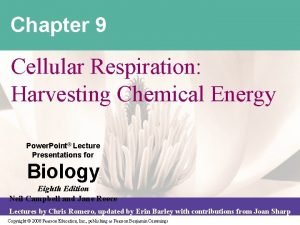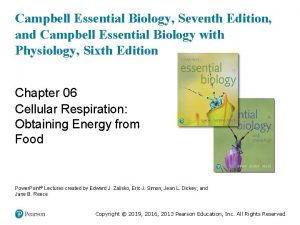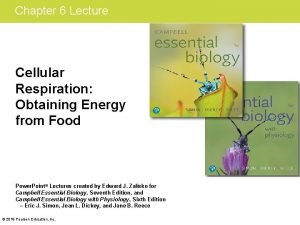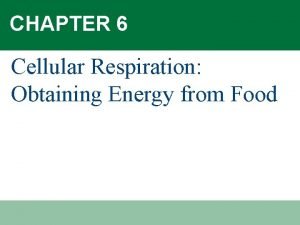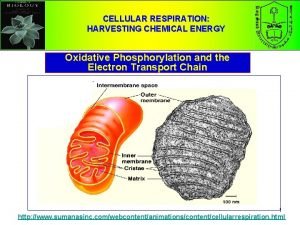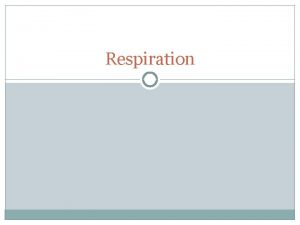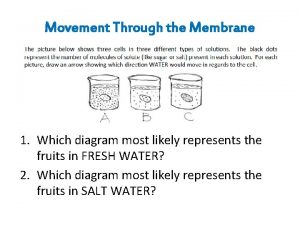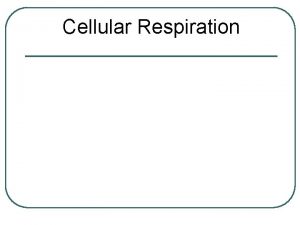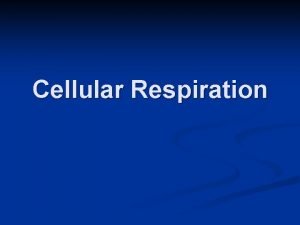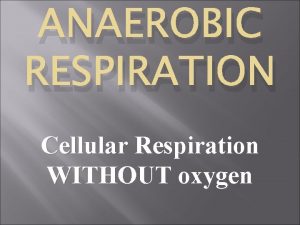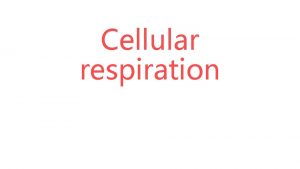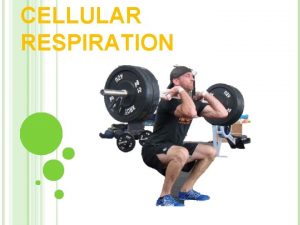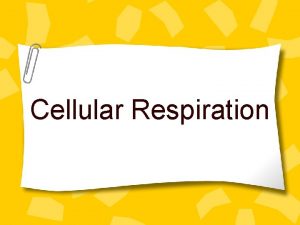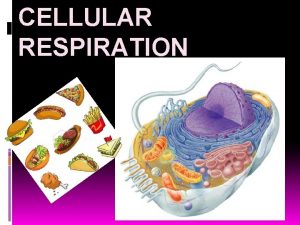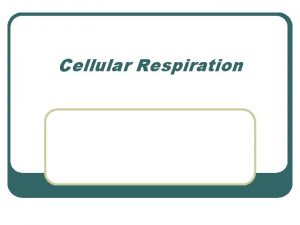Cellular Respiration Energy Conversion Why Convert energy to



















- Slides: 19

Cellular Respiration Energy Conversion

Why? • Convert energy to forms usable by cells – Chemical bond energy ATP energy – ATP via chemiosmosis; NADH via redox reaction – Electron transport – Electrochemical proton concentration gradient • Have store of ATP & NADH molecules available • Drive cellular processes – Transportation of metabolites, organelles, etc… – Locomotion of cell – Synthesizing complex molecules

ATP = adenosine triphosphate • Adenosine – Adenine = nitrogenous purine base – Ribose = a cyclic 5 -carbon sugar • Triphosphate – Phosphate is negatively charged polyatomic ion – Placing phosphates near each other requires work – Energy of electrostatic repulsion is stored in bond – Broken bond releases energy for doing work


Who? • Aerobic bacteria • All aerobic eukaryotic organisms – 1000 to 2000 mitochondria in each liver cell – Mitochondria associated with microtubules – May move in cytoplasm or be fixed in location • • Concentrated in areas of high energy demands Form long chains with each other Wrapped around flagellum Packed between cardiac myofibrils

Amoeba proteus

Where? • Mitochondrion is site of oxidative respiration • Mitochondria have double membranes – Inner vs. outer membrane • Outer membrane has transport proteins & large pores • Inner membrane is selectively permeable; forms cristae • Membranes create 2 internal compartments – Matrix is inside organelle • Enzyme-rich mixture, m. DNA, ribosomes, t. RNA, etc… – Intermembrane space is between membranes. • Site of ATP synthesis


When? • Begins when large amounts of acetyl coenzyme A (acetyl Co. A)are produced in the matrix space • Major fuel is acetyl Co. A from pyruvate usually • Stores of fatty acids & glycogen fuel process – Fats are stored in adipose tissue (fuel for 1 month) – Glycogen/ glucose is stored in liver (fuel for 1 day) – Glucose via glycolysis yields pyruvate


When else? • Fats can be broken down into fatty acids and glycerol – Glycerol broken down in glycolysis to pyruvate – Fatty acids broken down into 2 -C fragment • Proteins can be broken down into amino acids – Certain amino acids can lose NH 3 to form pyruvate – Some amino acids minus NH 3 form 2 -C fragment • Pyruvate/2 -C fragment (acetyl Co. A) enters mitochondria for citric acid cycle

How? • Glycolysis – Sugar is broken down into pyruvic acid + 2 ATP • Citric acid cycle (Kreb’s cycle) – Acetyl Co. A from pyruvate enters cycle – H 2 O supplies extra O 2 & H+ & electrons – 2 CO 2 + 2 NADH + FADH 2 + 2 GTP exit • Electron transport chain – Electrons from NADH move down chain – 26 ATP formed via ATP synthase


Anaerobic: Step 1 • Glycolysis ØC 6 H 12 O 6 2 C 3 H 3 O 3 - + 2 ATP + 2 NADH (net) ØGlucose via 9 steps is broken down into 2 pyruvates • 3 -C Pyruvate 2 -C acetyl Co. A + CO 2

Citric Acid Cycle: Step 2 • Citric acid cycle (Kreb’s cycle) in matrix ØPyruvate Acetyl Co. A + CO 2 + NADH ØAcetyl Co. A enters Kreb’s cycle ØKreb’s has 8 enzymatic reactions that harvest electrons ØNAD+ accepts electrons NADH carries electrons ØCO 2 + electrons (NADH + FADH 2) + 2 ATP & H+ movement are end products


Electron Transport Chain • Oxidative phosphorylation – In inner mitochondrial membrane – Electrons are delivered by NADH – Electrons move down chain of proteins – H+ build up in mitochondrial intermembrane space due to movement of electrons ØATP synthase is powered by H+ movement across membrane Ø 26 ATP are produced ؽ O 2 + 2 H+ H 2 O {oxygen is final electron acceptor)


Final Count • Glucose + oxygen carbon dioxide + water + 38 ATP
 What is the process of fermentation
What is the process of fermentation Why is cellular respiration important
Why is cellular respiration important Chapter 9 cellular respiration harvesting chemical energy
Chapter 9 cellular respiration harvesting chemical energy Inputs of glycolysis
Inputs of glycolysis Consumer
Consumer Explain how amp stimulates cellular respiration
Explain how amp stimulates cellular respiration Chapter 9: cellular respiration: harvesting chemical energy
Chapter 9: cellular respiration: harvesting chemical energy Cellular respiration obtaining energy from food
Cellular respiration obtaining energy from food Cellular respiration obtaining energy from food
Cellular respiration obtaining energy from food Phosphorelation
Phosphorelation Andreas carlsson bye bye bye
Andreas carlsson bye bye bye Cellular respiration redox
Cellular respiration redox The gray-brown haze often found over large cities is called
The gray-brown haze often found over large cities is called Chemiosmosis steps
Chemiosmosis steps Aerobic vs anaerobic
Aerobic vs anaerobic Complimentary processes
Complimentary processes Chemical equation for cellular respiration
Chemical equation for cellular respiration Cellular respiration reactants
Cellular respiration reactants Photosynthesis formula
Photosynthesis formula Starting materials for cellular respiration
Starting materials for cellular respiration

